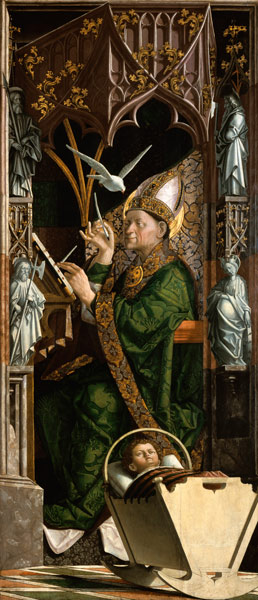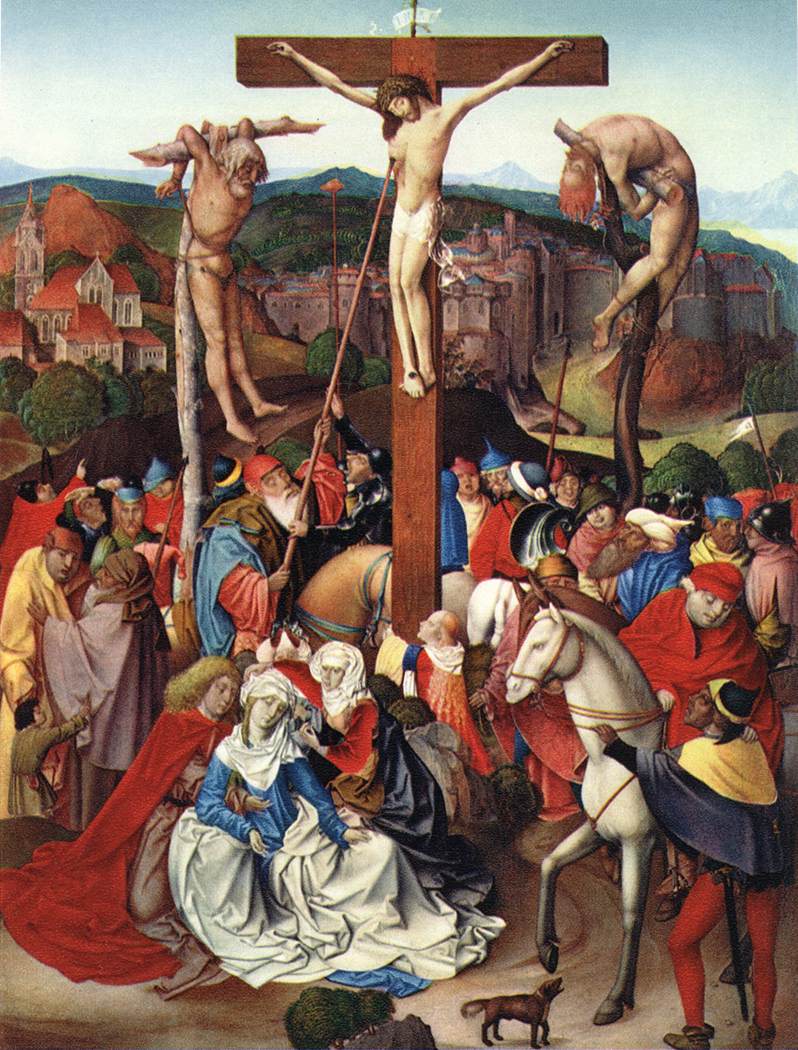|
Rueland Frueauf The Elder
Rueland Frueauf the Elder (c. 1440 – 1507) was an Austrian Late-Gothic painter. Biography Frueauf was born in Obernberg am Inn, and lived and worked there most of his life. He primarily painted frescoes in local churches. In 1484 he was appointed as a consultant to work with Michael Pacher on an altarpiece for the Franciscan Order. His son Rueland Frueauf the Younger also became a painter. Frueauf the Elder died in Passau Passau (; bar, label=Central Bavarian, Båssa) is a city in Lower Bavaria, Germany, also known as the Dreiflüssestadt ("City of Three Rivers") as the river Danube is joined by the Inn from the south and the Ilz from the north. Passau's popu ... in 1507. Gallery Rueland Frueauf d. Ä. - Verkündigung an Maria - 4838 - Kunsthistorisches Museum.jpg, ''Annunciation to Mary'' (1490) Cerchia di rueland frueauf il vecchio, madonna in trono tra i ss. giorgio e vigilio col canonico giorgio nothaft, 1490 ca. 01.jpg, Madonna enthroned between Saint George ... [...More Info...] [...Related Items...] OR: [Wikipedia] [Google] [Baidu] |
Gothic Art
Gothic art was a style of medieval art that developed in Northern France out of Romanesque art in the 12th century AD, led by the concurrent development of Gothic architecture. It spread to all of Western Europe, and much of Northern, Southern and Central Europe, never quite effacing more classical styles in Italy. In the late 14th century, the sophisticated court style of International Gothic developed, which continued to evolve until the late 15th century. In many areas, especially Germany, Late Gothic art continued well into the 16th century, before being subsumed into Renaissance art. Primary media in the Gothic period included sculpture, panel painting, stained glass, fresco and illuminated manuscripts. The easily recognizable shifts in architecture from Romanesque to Gothic, and Gothic to Renaissance styles, are typically used to define the periods in art in all media, although in many ways figurative art developed at a different pace. The earliest Gothic art was monumental ... [...More Info...] [...Related Items...] OR: [Wikipedia] [Google] [Baidu] |
Obernberg Am Inn
Obernberg am Inn is a municipality in the district of Ried im Innkreis in the Austrian state of Upper Austria. Geography Obernberg lies in the Innviertel The Innviertel (literally German for "Inn Quarter"; officially called the ''Innkreis''; ) is a traditional Austrian region southeast of the Inn river. It forms the western part of the state of Upper Austria and borders the German state of Bavari .... About 9 percent of the municipality is forest, and 48 percent is farmland. References File:Obernberg am Inn Stadtplatz 2.jpg Cities and towns in Ried im Innkreis District {{UpperAustria-geo-stub ... [...More Info...] [...Related Items...] OR: [Wikipedia] [Google] [Baidu] |
Michael Pacher
Michael Pacher ( 1435 – August 1498) was a painter and sculptor from Tyrol active during the second half of the fifteenth century. He was one of the earliest artists to introduce the principles of Renaissance painting into Germany. Pacher was a comprehensive artist with a broad range of sculpting, painting, and architecture skills producing works of complex wood and stone. He painted structures for altarpieces on a scale unparalleled in North European art. Pacher's masterpiece, the ''St. Wolfgang Altarpiece'' (1471–1481), is considered one of the most remarkable carved and painted altar shrines in all of European art. It contains scenes from the life of Jesus and the Virgin Mary.Osborne, p. 801. Pacher's other great work, the ''Altarpiece of the Church Fathers'', created in 1483 for Neustift Monastery, combined painting and sculpture to produce a unique art form. Pacher's influence was primarily North Italian, and his work shares characteristics with that of painters such as ... [...More Info...] [...Related Items...] OR: [Wikipedia] [Google] [Baidu] |
Franciscan
The Franciscans are a group of related Mendicant orders, mendicant Christianity, Christian Catholic religious order, religious orders within the Catholic Church. Founded in 1209 by Italian Catholic friar Francis of Assisi, these orders include three independent orders for men (the Order of Friars Minor being the largest contemporary male order), orders for women religious such as the Order of Saint Clare, and the Third Order of Saint Francis open to male and female members. They adhere to the teachings and spiritual disciplines of the founder and of his main associates and followers, such as Clare of Assisi, Anthony of Padua, and Elizabeth of Hungary. Several smaller Franciscan spirituality in Protestantism, Protestant Franciscan orders exist as well, notably in the Anglican and Lutheran traditions (e.g. the Community of Francis and Clare). Francis began preaching around 1207 and traveled to Rome to seek approval from Pope Innocent III in 1209 to form a new religious order. The o ... [...More Info...] [...Related Items...] OR: [Wikipedia] [Google] [Baidu] |
Rueland Frueauf The Younger
Rueland Frueauf the Younger (c. 1470 – after 1545) was a German Late-Gothic painter. Biography Frueauf was born in Salzburg Salzburg (, ; literally "Salt-Castle"; bar, Soizbuag, label= Austro-Bavarian) is the fourth-largest city in Austria. In 2020, it had a population of 156,872. The town is on the site of the Roman settlement of ''Iuvavum''. Salzburg was founded ..., and later moved to Passau where he lived and worked for the rest his life. He produced primarily paintings, altarpieces, and frescoes for local churches. His father Rueland Frueauf the Elder was also a painter. Frueauf the Younger died in Passau. References 15th-century German painters German male painters 16th-century German painters 1545 deaths 1470 births Gothic painters {{Germany-painter-stub ... [...More Info...] [...Related Items...] OR: [Wikipedia] [Google] [Baidu] |
Passau
Passau (; bar, label=Central Bavarian, Båssa) is a city in Lower Bavaria, Germany, also known as the Dreiflüssestadt ("City of Three Rivers") as the river Danube is joined by the Inn from the south and the Ilz from the north. Passau's population is approx. 50,000, of whom about 12,000 are students at the University of Passau, renowned in Germany for its institutes of economics, law, theology, computer science and cultural studies. History In the 2nd century BC, many of the Boii tribe were pushed north across the Alps out of northern Italy by the Romans. They established a new capital called Boiodurum by the Romans (from Gaulish ''Boioduron''), now within the Innstadt district of Passau. Passau was an ancient Roman colony called Batavis, Latin for "for the ''Batavi''." The Batavi were an ancient Germanic tribe often mentioned by classical authors, and they were regularly associated with the Suebian marauders, the Heruli. ''Batavis'' (Passau-Altstadt) was a Roman castrum in ... [...More Info...] [...Related Items...] OR: [Wikipedia] [Google] [Baidu] |
Saint George
Saint George (Greek: Γεώργιος (Geórgios), Latin: Georgius, Arabic: القديس جرجس; died 23 April 303), also George of Lydda, was a Christian who is venerated as a saint in Christianity. According to tradition he was a soldier in the Roman army. Saint George was a soldier of Cappadocian Greek origin and member of the Praetorian Guard for Roman emperor Diocletian, who was sentenced to death for refusing to recant his Christian faith. He became one of the most venerated saints and megalomartyrs in Christianity, and he has been especially venerated as a military saint since the Crusades. He is respected by Christians, Druze, as well as some Muslims as a martyr of monotheistic faith. In hagiography, as one of the Fourteen Holy Helpers and one of the most prominent military saints, he is immortalized in the legend of Saint George and the Dragon. His memorial, Saint George's Day, is traditionally celebrated on 23 April. Historically, the countries of England, Ukrai ... [...More Info...] [...Related Items...] OR: [Wikipedia] [Google] [Baidu] |
Vigilius Of Trent
Saint Vigilius of Trent ( it, San Vigilio di Trento, german: Vigilius von Trient; c. 353 – 26 June 405) is venerated as the patron saint and bishop of Trent. He should not be confused with the pope of the same name. Life According to tradition, he was a Roman patrician, the son of Maxentia and a man whose name is sometimes given as Theodosius. His brothers, Claudian and Magorian, are also venerated as saints. Vigilius was educated at Athens and seems to have been a friend of Saint John Chrysostom. In 380, Vigilius settled in the city of Trent and was chosen as the city's bishop. He may have been consecrated by either Ambrose of Milan or Valerian (Valerianus) of Aquileia. Ambrose donated the episcopal insignia and showed a paternal solicitude for Vigilius. As bishop, Vigilius attempted to convert Arians and pagans to Nicene Christianity and is said to have founded thirty parishes in his diocese. He is traditionally regarded as the founder of the Church of Santa Maria Mag ... [...More Info...] [...Related Items...] OR: [Wikipedia] [Google] [Baidu] |
Saint Apollonia
Saint Apollonia ( el, Αγία Απολλωνία, cop, Ϯⲁⲅⲓⲁ Ⲁⲡⲟⲗⲗⲟⲛⲓⲁ) was one of a group of virgin martyrs who suffered in Alexandria during a local uprising against the Christians prior to the persecution of Decius. According to church tradition, her torture included having all of her teeth violently pulled out or shattered. For this reason, she is popularly regarded as the patroness of dentistry and those suffering from toothache or other dental problems. French court painter Jehan Fouquet painted the scene of St. Apollonia's torture in ''The Martyrdom of St. Apollonia''. Martyrdom Ecclesiastical historians have claimed that in the last years of Emperor Philip the Arabian (reigned 244–249), during otherwise undocumented festivities to commemorate the millennium of the founding of Rome (traditionally in 753 BC, putting the date about 248), the fury of the Alexandrian mob rose to a great height, and when one of their poets prophesied a calamit ... [...More Info...] [...Related Items...] OR: [Wikipedia] [Google] [Baidu] |
Alte Pinakothek
The Alte Pinakothek (, ''Old Pinakothek'') is an art museum located in the Kunstareal area in Munich, Germany. It is one of the oldest galleries in the world and houses a significant collection of Old Master paintings. The name Alte (Old) Pinakothek refers to the time period covered by the collection—from the fourteenth to the eighteenth century. The Neue Pinakothek, re-built in 1981, covers nineteenth-century art, and Pinakothek der Moderne, opened in 2002, exhibits modern art. All three galleries are part of the Bavarian State Painting Collections, an organization of the Free state of Bavaria. The building King Ludwig I of Bavaria ordered Leo von Klenze to erect a new building for the gallery for the Wittelsbach collection in 1826. The Alte Pinakothek was the largest museum in the world and structurally and conceptually well advanced through the convenient accommodation of skylights for the cabinets. Even the Neo-Renaissance exterior of the Pinakothek clearly stands out ... [...More Info...] [...Related Items...] OR: [Wikipedia] [Google] [Baidu] |
15th-century Austrian Painters
The 15th century was the century which spans the Julian dates from 1 January 1401 ( MCDI) to 31 December 1500 ( MD). In Europe, the 15th century includes parts of the Late Middle Ages, the Early Renaissance, and the early modern period. Many technological, social and cultural developments of the 15th century can in retrospect be seen as heralding the "European miracle" of the following centuries. The architectural perspective, and the modern fields which are known today as banking and accounting were founded in Italy. The Hundred Years' War ended with a decisive French victory over the English in the Battle of Castillon. Financial troubles in England following the conflict resulted in the Wars of the Roses, a series of dynastic wars for the throne of England. The conflicts ended with the defeat of Richard III by Henry VII at the Battle of Bosworth Field, establishing the Tudor dynasty in the later part of the century. Constantinople, known as the capital of the world and ... [...More Info...] [...Related Items...] OR: [Wikipedia] [Google] [Baidu] |









